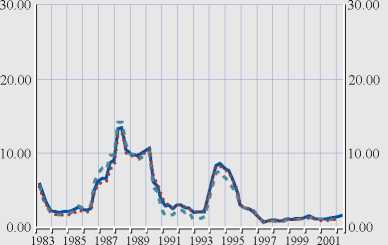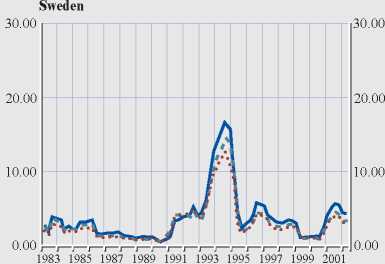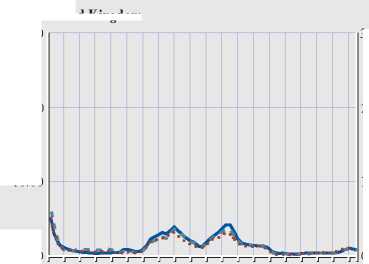4 ANNEXES
Chart 11 Sectoral shifts and volatility (rescaled) (cont’d)

Denmark

United Kingdom

20.00

0.00
0.00
1983 1985 1987 1989 1991 1993 1995 1997 1999 2001
30.00


10.00

20.00

10.00
The figure reports the variance of the aggregate business
cycle component at the actual sectoral specialisation for
each individual observation (solid line) and the variance
of the aggregate business cycle component where the
sectoral specialisation has been fixed at its initial value
(dashed line).
Sources : Eurostat, NCBs, ECB calculations.
Note: See Annex 4.2.2.2 for a discussion of the underlying methodology and a presentation of volatility developments using the same scale for
all countries.
chosen filter parameters, except for agriculture
where very strong reactions can be detected.
4.2.2.2 SECTORAL DECOMPOSITION OF
AGGREGATEVOLATILITY
The decomposition in Table 6 and the
assessment in Chart 9 follow the formula for the
variance of joint distributions:
2 2
Var[ax + by + c] = a Var[x] + b Var[y] + 2abCov[x, y]
In order to facilitate cross-country comparability,
Chart 9 has been reproduced in Chart 11, using
the same scale for all countries.
P к, t = « к + ∑ β, P,, к, t + ε,, к, t
i
where qk,t represents the synchronisation
coefficient of country k at time t and qi,k,t
represents the synchronisation coefficient of
industry i in country k at time t. The regression
coefficients were estimated using the within-
estimator with country-fixed effects, ak, and
accounting for serial correlations of the
synchronisation coefficients as described by
Baltagi and Wu (1999)58. Results were reported
according to whether the bi were found to be
statistically significant at the 5% level or not.
4.2.2.3 SECTORAL DETERMINANTS OF BUSINESS
CYCLE SYNCHRONISATION
The results in Table 11 were established by
running the following regression:
58 B. H. Baltagi and P. X. Wu (1999), “Unequally spaced panel data
regressions with AR(1) disturbances”, Econometric theory, 15,
pp. 814-823.
ECB
Occasional Paper No. 19
July 2004
More intriguing information
1. Eigentumsrechtliche Dezentralisierung und institutioneller Wettbewerb2. Developmental Robots - A New Paradigm
3. Non-causality in Bivariate Binary Panel Data
4. Barriers and Limitations in the Development of Industrial Innovation in the Region
5. The name is absent
6. The name is absent
7. The problem of anglophone squint
8. The name is absent
9. The Role of Immigration in Sustaining the Social Security System: A Political Economy Approach
10. The name is absent